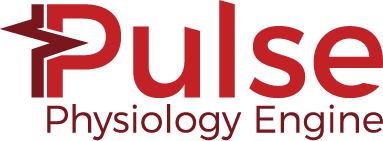Pulse 4.3 Release


On behalf of the Pulse Physiology Community, we are pleased to announce that version 4.3 is now available from our repository. The Pulse Explorer has also been updated and can assist in developing applications built on this version.
We have continued to support commercial, academic, and government institutions in integrating Pulse into their projects and product goals. We have worked closely with users to improve models and functionality to meet their needs. Highlights of the 4.3 release include:
Common Data Model API Changes
- Blood Chemistry System Data
- Added PlasmaOsmolality and PlasmaOsmolarity
- Respiratory System Data
- Added ExtrinsicPositiveEndExpiratoryPressure
- Changed InspiratoryPulmonaryResistance to InspiratoryRespiratoryResistance
- Changed IntrinsicPositiveEndExpiredPressure to IntrinsicPositiveEndExpiratoryPressure
- Changed ExpiratoryPulmonaryResistance to ExpiratoryRespiratoryResistance
- Changed PulmonaryCompliance to RespiratoryCompliance
- Changed PulmonaryElastance to RespiratoryElastance
- Changed PositiveEndExpiratoryPressure to TotalPositiveEndExpiratoryPressure
- Environmental Conditions Data
- Added MechanicalDeadSpace
- Anesthesia Machine Data
- Changed PositiveEndExpiredPressure to PositiveEndExpiratoryPressure
- Bag Valve Mask Data
- Changed ValvePositiveEndExpiredPressure to ValvePositiveEndExpiratoryPressure
- Mechanical Ventilator Data
- Added PeakInspiratoryFlow
- Added ExtrinsicPositiveEndExpiratoryPressure
- Changed PositiveEndExpiratoryPressure to TotalPositiveEndExpiratoryPressure
- Changed DynamicPulmonaryCompliance to DynamicRespiratoryCompliance
- Changed IntrinsicPositiveEndExpiredPressure to IntrinsicPositiveEndExpiratoryPressure
- Changed StaticPulmonaryCompliance to StaticRespiratoryCompliance
- Mechanical Ventilator Settings Data
- Added ExpiratoryResistance and InspiratoryResistance
- Changed PositiveEndExpiredPressure to PositiveEndExpiratoryPressure
- Mechanical Ventilator Continuous Positive Airway Pressure Data
- Changed PositiveEndExpiredPressure to PositiveEndExpiratoryPressure
- Mechanical Ventilator Pressure Control Data
- Changed PositiveEndExpiredPressure to PositiveEndExpiratoryPressure
- Mechanical Ventilator Volume Control Data
- Changed PositiveEndExpiredPressure to PositiveEndExpiratoryPressure
Software Architecture Improvements
- Data Set Generation Tools
- Initial patient set generator
- Can create large patient sets using permutations of starting HR, RR, MAP, Age, Height, BMI, BFF and other patient properties
- Injury set generator
- For each patient in a patient set, will apply and run a permutation of inujuries such as (but not limited to) Hemorrhage, AirwayObstruction, Tension Pneumothorax
- Convience modes provided to generate a set of preprogrammed TCCC injuries
- Initial patient set generator
- Combined DataModelBindings, CommonDataModel and PulseEngine into a single Pulse library
- This single library can be built as a shared/dynamic library or a static (default) library
- Implement system/patient validation framework in Python
- Provides access to more discrete modules in our validation pipeline for more versatile use
- Initial architecture for automated validation
- Currently only AirwayObstruction has been migrated
- Created a xlsx template for automating the our validation of our models (is currently being done by hand)
- The validation pipeline can also create a single doxygen report with a plot file and md files associated with an xlsx
- Added the ability to create vitals monitor and ventilator monitor plots from CSV files
- Created an Advance To Stable Action, this will run the engine until stable criteria is met
- Threaded execution of a group of scenarios now can be provided a single json file containing all scenario to run
- Information for every executed scenario is then updated in the provided file:
- The locations of the: scenario file and its generated log file, and csv file
- Various error states if encountered: Unable to initialize and why, if there were any other errors encountered
- Information for every executed scenario is then updated in the provided file:
- Post processing pipeline
- Written in python, allows us to process a log and csv file generated from a scenario and pull out (and even generate new) data into a more machine learning friendly format
- Unstructure Text Module looks at map of vitals to a string vector and randomly takes strings based on the vitals values to create an unstructured description of the simulation at that time. The strings and bounds are read in from a spreadsheet
- Written in python, allows us to process a log and csv file generated from a scenario and pull out (and even generate new) data into a more machine learning friendly format
- Testing Utils
- Add a run.cmake option to generate a config of all the failures for a quick and easy rebase (once they have been reviewed and approved of course)
- Remove action vertical lines in our verification plots of actions that occur many many times. These actions are usually testing sensor driven inputs and make data interpretation difficult.
- Fixed improperly mapped events
Physiology Model Improvements
- Updated dyspnea implementation
- Split single severity into a Respiration Rate severity and Tidal Volume severity
- This allows users to define breathing impairments with more precision
- Note any previous scenarios using Dyspnea severity should apply that value to the Tidal Volume severity
- Mechanical Ventilator Model
- Ventilation will immediately stop at limits for more precise targets
- Apneic patients will no long trigger the ventilator when the model trigger is selected
- Update naming conventions and parameter calculations to be match more widely accepted definitions
- Respiratory Model
- Improved handling of lung recruitment based on acinar ventilation for showing the pulmonary shunt changes due to increased ventilator PEEP
- Calibrated respiratory diseases for mechanically ventilated patients, including ARDS and COPD
- Added mechanoreceptor feedback that inhibits the inspiratory drive and reduces the respiratory muscle pressure during an assisted breath
- Modifier Actions (SECardiovascularMechanicsModification, SERespiratoryMechanicsModification)
- We now provide 2 new actions to modify the respiratory and cardiovascular model parameters
- For example, you can provide a multipliers to modify the heart rate, respiration rate, systemic vascular and pulmonary resistances
- This provides the end user more low level control to fine tune the physiology to their specific needs
- The application of drug pharmacodynamics changes to the cardiovascular system now include pulse pressure as well as mean arterial pressure
- Acute stress is more inline with validation data
- Updated body fluid and perspiration methodology
- Added sweat substance loss using a substance compound definition
- Updated the sweat rate methodology to better meet validation
- Calibrated the convective/evaporative heat loss due to sweating
- Fixed a bug for substance tissue diffusion between the vascular and extracellular spaces
- Added new system data outputs for total body fluid volume, plasma osmolality, and plasma osmolarity
- Added a dehydration condition model that directly affects the Tissue, Cardiovascular and Energy systems
- Associated new events: Hypernatremia Hyponatremia, MildDehydration, ModerateDehydration, SevereDehydration
- Added a mechanical dead space parameter to the Environment
- Updated the urinalysis assessment with more appropriate substance thresholds
- Added logic for several missing events: hyperglycemia, hypoglycemia, ketoacidosis, and lactic acidosis
In the coming months, we plan to improve and extend Pulse by focusing on:
- Updating the Unity asset on the Unity Store and Unreal Engine plugin with the latest version of Pulse.
- Adding a segmented bronchopulmonary compartment model for heterogeneous lung damage simulation.
- Advancing hardware-in-loop testing and training infrastructure for mechanical ventilators and advanced life support systems.
- Improving patient generation tools, particularly for synthetic data creation for machine learning algorithms.
For more information on our efforts and our users, visit our website or sign up for our newsletter. If you would like to feature your Pulse use case on our website, please email us at kitware@kitware.com.